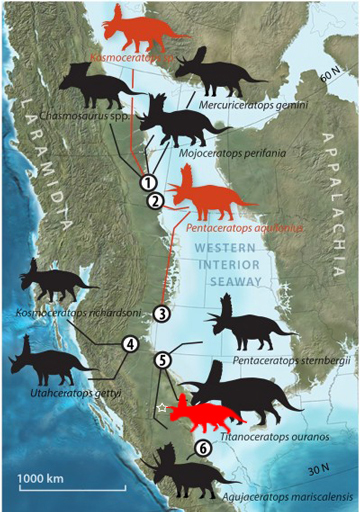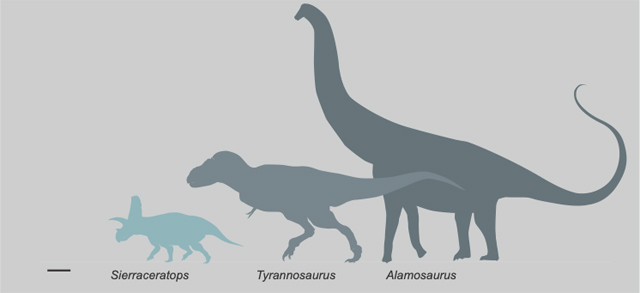A new species of horned dinosaur has been named and described from fossils found in New Mexico. The dinosaur has been named Sierraceratops turneri and it was distantly related to Triceratops.
The new horned dinosaur classified as a member of the Chasmosaurinae, roamed New Mexico approximately 72 million years ago (latest Campanian–Maastrichtian). Sierraceratops adds to the diversity and disparity of the Chasmosaurinae in the Late Cretaceous. This discovery provides supporting evidence for the hypothesis of Laramidian endemism – the idea that species were restricted to specific regions. Together with Sierraceratops, the Hall Lake Formation dinosaur fauna suggests that the latest Cretaceous of southern Laramidia was characterised by endemic clades and distinct dinosaur communities.

From Sierra County, New Mexico
The first fossil material associated with this new horned dinosaur, was discovered in 1997 by Greg H. Mack of New Mexico State University whilst undertaking a geological survey. Most of the fossils were collected from the surface, having already weathered out of the surrounding rock, but a field team from the New Mexico Museum of Natural History was despatched and additional fossils were found. The remainder of the fossil material that led to the naming of Sierraceratops was excavated between 2014-2016 by other field teams sent out to the site by the New Mexico Museum of Natural History. The fossils include elements from the skull and jaws, along with two neckbones (cervicals), two dorsal vertebrae, the sacrum, scapulocoracoid, the ilium and limb bones. The genus name honours Sierra County where the fossils were found, whilst the species name is a tribute to Mr Ted Turner, the founder of the Cable News Network (CNN) who owned the land where the fossils were collected.
Distinct Dinosaur Regional Communities
Phylogenetic analysis suggests that Sierraceratops is a sister taxon to Bravoceratops and Coahuilaceratops, forming part of a clade endemic to the southwestern United States and Mexico. Sierraceratops adds to the diversity and disparity of the Chasmosaurinae in the Late Cretaceous and provides supporting evidence for the hypothesis of Laramidian endemism. Dinosaur fossils from the Hall Lake Formation suggest that the dinosaur biota of southern Laramida was characterised by distinct dinosaur communities. Similar types of dinosaurs could be found in other areas, but the genera were distinctive.

Recent Discoveries of Horned Dinosaurs from New Mexico
New Mexico has proved to be a happy hunting ground for new ceratopsid discoveries in recent years. For example, some of the authors of the Sierraceratops paper also worked on the publication describing Menefeeceratops (M. sealeyi), from the Menefee Formation. Menefeeceratops roamed New Mexico some 10 million years before Sierraceratops evolved. As Menefeeceratops has been classified as a member of the Centrosaurinae and Sierraceratops is regarded as a chasmosaurine, these two horned dinosaurs were only distantly related.
To read Everything Dinosaur’s article about Menefeeceratops: Menefeeceratops – the Oldest Centrosaurine.
Sierraceratops turneri – Tyrannosaurs and Titanosaurs
Based on a comparison with better-known chasmosaurine fossil specimens, Sierraceratops is estimated to have measured around five metres in length. Its skull would have been around 1.5 metres long. The scientists behind this research, including Dr Nicholas Longrich (senior lecturer in the Department of Biology and Biochemistry at the University of Bath), predict that several more new dinosaurs will be described from Laramidia.
Sierraceratops shared its lush, floodplain and swamp environment with other dinosaurs including giant titanosaurs and predatory tyrannosaurids. It also highly likely that Sierraceratops was contemporaneous with other plant-eating dinosaurs such as hadrosaurids and ankylosaurids. Fossil evidence for both armoured dinosaurs and duck-billed dinosaurs have been found in other Hall Lake Formation sediments but their stratigraphical relationship to the Sierraceratops material remains undetermined.

Everything Dinosaur acknowledges the assistance of a media release from the University of Bath in the compilation of this article.
The scientific paper: “Sierraceratops turneri, a new chasmosaurine ceratopsid from the Hall Lake Formation (Upper Cretaceous) of south-central New Mexico” by Sebastian G. Dalman, Spencer G Lucas, Steven E. Jasinski and Nicholas R. Longrich published in Cretaceous Research.






Leave A Comment